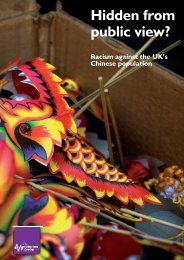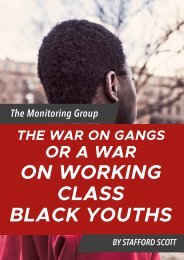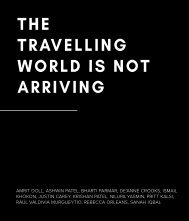Coming of Age : 1976 and the Road to Anti-Racism
Coming of Age : 1976 and the Road to Anti-Racism by Jagdish Patel and Suresh Grover
Coming of Age : 1976 and the Road to Anti-Racism
by Jagdish Patel and Suresh Grover
You also want an ePaper? Increase the reach of your titles
YUMPU automatically turns print PDFs into web optimized ePapers that Google loves.
A racial division <strong>of</strong> labour (continued more from Britain’s colonial past than inaugurated in post-war Britain) kept <strong>the</strong><br />
Asian <strong>and</strong> Afro-Caribbean workers apart <strong>and</strong> provided little ground for common struggle. Besides, <strong>the</strong> black workforce<br />
at this time, though concentrated in certain labour processes <strong>and</strong> areas <strong>of</strong> work, was not in absolute terms<br />
a large one — with West Indians outnumbering Indians <strong>and</strong> Pakistanis. Hence, <strong>the</strong> resistance <strong>to</strong> racial abuse <strong>and</strong><br />
discrimination on <strong>the</strong> shop floor was more spontaneous than organised — but both individual <strong>and</strong> collective. Some<br />
workers left <strong>the</strong>ir jobs <strong>and</strong> went <strong>and</strong> found o<strong>the</strong>r work. O<strong>the</strong>rs just downed <strong>to</strong>ols <strong>and</strong> walked away. On one occasion<br />
a Jamaican driver, incensed by <strong>the</strong> racialism around him, just left his bus in <strong>the</strong> High Street <strong>and</strong> walked <strong>of</strong>f. (It was a<br />
tradition that reached back <strong>to</strong> his slave ancestry <strong>and</strong> would reach forward <strong>to</strong> his children.) But <strong>the</strong>re were also efforts<br />
at collective action on <strong>the</strong> fac<strong>to</strong>ry floor. Often <strong>the</strong>se <strong>to</strong>ok <strong>the</strong> form <strong>of</strong> petitions <strong>and</strong> appeals regarding working<br />
conditions, facilities, even wages but unsupported by <strong>the</strong>ir white fellows, <strong>the</strong>y had little effect. On occasions, <strong>the</strong>re<br />
were attempts <strong>to</strong> form associations, if not unions, on <strong>the</strong> shop floor. In 1951, for instance, skilled West Indians in an<br />
ordnance fac<strong>to</strong>ry in Merseyside (Liverpool) met secretly in <strong>the</strong> lava<strong>to</strong>ries <strong>and</strong> wash rooms <strong>to</strong> form a West Indian<br />
Association which would take up cases <strong>of</strong> discrimination. But <strong>the</strong> employers soon found out <strong>and</strong> <strong>the</strong>y were driven <strong>to</strong><br />
hold <strong>the</strong>ir meetings in a neighbouring barber’s shop — from which point <strong>the</strong> association became more community<br />
oriented. Similarly, in 1953 Indian workers in Coventry formed an association <strong>and</strong> named it (in <strong>the</strong> memory <strong>of</strong> Udham<br />
Singh) <strong>the</strong> Indian Workers’ Association. But <strong>the</strong>se early organisations generally ended up as social <strong>and</strong> welfare associations.<br />
The Merseyside West Indian Association, for instance. went through a period <strong>of</strong> vigorous political activity —<br />
taking up cases <strong>of</strong> discrimination <strong>and</strong> <strong>the</strong> cause <strong>of</strong> colonial freedom — but even as it grew in numbers <strong>and</strong> out <strong>of</strong> its<br />
barber’s shop premises <strong>and</strong> in<strong>to</strong> <strong>the</strong> white run Stanley House, it faded in<strong>to</strong> inter-racial social activity <strong>and</strong> oblivion. (2)<br />
Discrimination in housing met with a community response from <strong>the</strong> outset: it was not, after all, a problem that<br />
was susceptible <strong>to</strong> individual solutions. Denied decent housing (or sometimes any housing at all), both Asians<br />
<strong>and</strong> Afro-Caribbean’s’ <strong>to</strong>ok <strong>to</strong> pooling <strong>the</strong>ir savings till <strong>the</strong>y were sizeable enough <strong>to</strong> purchase property. The<br />
Asians operated through an extended family system or ‘mortgage clubs’ <strong>and</strong> bought short lease properties which<br />
<strong>the</strong>y would rent <strong>to</strong> <strong>the</strong>ir kinsfolk <strong>and</strong> countrymen. Similarly, <strong>the</strong> West Indians operated a ‘pardner’ (Jamaican) or<br />
‘sou-sou’ (Trinidadian) system, whereby a group <strong>of</strong> people would pool <strong>the</strong>ir savings <strong>and</strong> lend out a lump sum <strong>to</strong><br />
each individual in turn. Thus, <strong>the</strong>ir savings circulated among <strong>the</strong>ir communities <strong>and</strong> did not go in<strong>to</strong> <strong>the</strong> banks or<br />
building societies <strong>to</strong> be lent out <strong>to</strong> white folk. It was a sort <strong>of</strong> primitive banking system engendered by tradition<br />
<strong>and</strong> enforced by racial discrimination. Of course, <strong>the</strong> prices <strong>the</strong> immigrants had <strong>to</strong> pay for <strong>the</strong> house <strong>and</strong> <strong>the</strong> interest<br />
rates charged by <strong>the</strong> sources that were prepared <strong>to</strong> lend <strong>to</strong> <strong>the</strong>m forced <strong>the</strong>m in<strong>to</strong> overcrowding <strong>and</strong> multi<br />
occupation, invoking not only fur<strong>the</strong>r racial stereotyping but, in later years, <strong>the</strong> rigours <strong>of</strong> <strong>the</strong> Public Health Act.<br />
Thus, it was around housing principally, but through traditional cultural <strong>and</strong> welfare associations<br />
<strong>and</strong> groups, that black self organisation <strong>and</strong> self reliance grew, unifying <strong>the</strong> perspective<br />
communities. It was strength that was <strong>to</strong> st<strong>and</strong> <strong>the</strong>m in good stead in <strong>the</strong> struggles <strong>to</strong> come.<br />
There was ano<strong>the</strong>r area. <strong>to</strong>o, where such organisation was significant — <strong>and</strong> <strong>of</strong>fered up a different unity: <strong>the</strong> area<br />
<strong>of</strong> anti-colonial struggle. There had always been overseas students’ association — African, Asian, Caribbean — but<br />
in <strong>the</strong> period before <strong>the</strong> First World War <strong>the</strong>se were mostly in <strong>the</strong> nature <strong>of</strong> friendship councils, social clubs or debating<br />
unions. But after that war <strong>and</strong> with <strong>the</strong> ‘race riots’ <strong>of</strong> 1919 (in Liverpool. London, Cardiff, Hull <strong>and</strong> o<strong>the</strong>r port<br />
areas where West African <strong>and</strong> lascar seamen had earlier settled) still fresh in <strong>the</strong>ir mind, West African students<br />
<strong>Coming</strong> <strong>of</strong> <strong>Age</strong> | 39<br />
<strong>Coming</strong> <strong>of</strong> <strong>Age</strong> Final version 16.10.indd 39 17/10/2017 12:07







